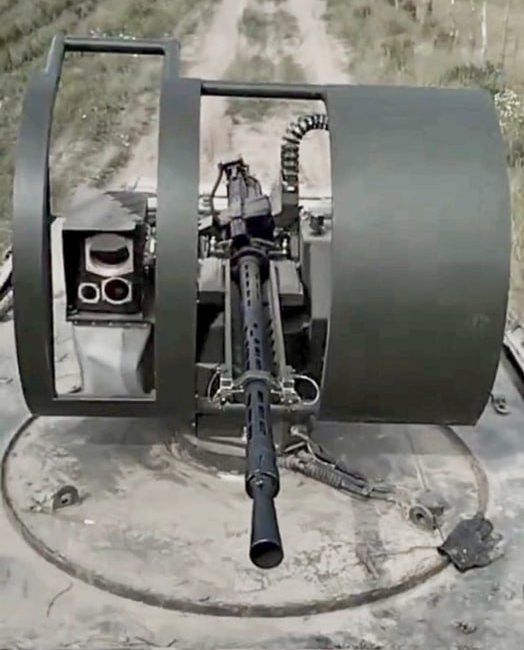The first appearance of these rather strange-looking combat vehicles was seen in early June this year. Then their origin, characteristics, and even names were not yet known. However, Militarnyi managed to find people associated with them and find out all the details.
Meet a Ukrainian BMP-1LB infantry fighting vehicle. Developed in the conditions of war, its main task was to mechanize the numerous newly launched brigades of the Armed Forces of Ukraine and compensate for the losses of armored vehicles in existing units.

As it became known from a conversation with a person involved in the production of these vehicles, they are made from the hulls of Soviet MT-LB tracked armored personnel carriers, which are in large quantities in tank depots.
Vehicles undergo major repairs with complete disassembly and flaws, after which they are painted and reassembled.
The actual outcome of the repair is quite low-grade due to the poor quality of the work. As noted, standard engines undergo major maintenance, but their “run-in” on the stand before transmission is only 50 hours, which often turns out to be insufficient.
“If the outside of the vehicles is cleaned, primed, and painted, the inside is smudged directly on rust and old peeling paint. On one vehicle, tracks with one extra element were installed, which is why we already had to shorten the tracks in the field,” the source said.
Upon completion of the repair, numerous changes are made to the design of the vehicles, in particular the arrangement of the squad compartment, strengthening the firepower and protection.
Protection of the original MT-LB in the sides and stern is only 7 mm, and in the front, up to 14 mm. This is only enough to protect against small debris and light rifle fire, but rifles and machine guns’ fire can penetrate the hull. To compensate for this drawback, add-on armored screens are welded on the BMP-1LB in a circle, forming spaced armor.
A remote weapon station with a KPVT 14.5mm heavy machine gun is also being installed on the vehicle. It is equipped with an optical observation station with a day-and-night thermal imaging channel. In addition, it is equipped with a protective armor shield against bullets and light debris.

According to our source, the RWSs are unreliable and have several problems. In addition to the fact that the KPVT itself is renowned for its sensitivity to contamination, the open installation design makes it even more vulnerable. The ammunition supply system is ill-conceived, there is a risk of dirt entering the cartridge supply chute.
In addition to the KPVT, the RWS does not have additional twin weapons, so in the case of a malfunction, the IFV remains unarmed.
The RWS is controlled from a gunner place, which is located in the depths of the squad compartment. Controls are represented by a monitor and joystick.

The crew of the combat vehicle consists of three people: a driver, a gunner-operator of weapons, and a vehicle commander. The squad compartment can accommodate 7-8 soldiers.
The source positively assesses the squad compartment leaving, noting that a larger door was made there and “footrests” were added.
“Not an approach ramp, as in the М113, but more or less normally, in a bulletproof vest, and with any downloads you can dismount. But the driver and the commander of the vehicle need to drop the bulletproof vest to get out,” he notes.

It is worth noting that the BMP-1LB shouldn’t be compared with other “peacetime technology” vehicles. It was designed in a short time with the lowest budgets, short terms, and for quick mass production, as well as the use of available resources.
Although the exact parameters are not available at the moment, it is clear that the Soviet MT-LB significantly increased in weight after modernization. This could affect the chassis because the original design is not elementary enough for such a payload.
In the first hundred kilometers, the vehicle begins to break since the engine or gearbox fails. Despite the small runs, many vehicles have already replaced belts in the cooling system. Often the caterpillars get out “fingers.” Strong vibration in motion is also one of the main shortcomings.
Excess mass is also affecting the mobility of the armored vehicle. On a straight road, it can reach speeds of up to 50 km/h, but the speed drops sharply with the emergency maneuvers between the obstacles.
According to the military, during the movement in forests, the speed of BMPs was sometimes equal to the speed of soldiers. Presumably, this disadvantage could cause losses in the forests in the area of Kreminna, where the Russians managed to hit one such vehicle with a bomb in early June.
BMP-1LB is still in the development phase, as evidenced by the constant modification of its design. Differences can even be found between vehicles in the same batch.
The cost of one such vehicle is known—about UAH 14 million, or $380,000. Of these, half the expense is a RWS, which, according to the documents, is manufactured and delivered from abroad.
In general, the production of these combat vehicles is a forced decision due to the shortage of standard armored personnel carriers and IFVs in the armed forces. The Ukrainian military-industrial complex and the state are trying in every possible way to compensate for this with their available funds and resources.
Підтримати нас можна через:
Приват: 5169 3351 0164 7408 PayPal - [email protected] Стати нашим патроном за лінком ⬇
Subscribe to our newsletter
or on ours Telegram
Thank you!!
You are subscribed to our newsletter